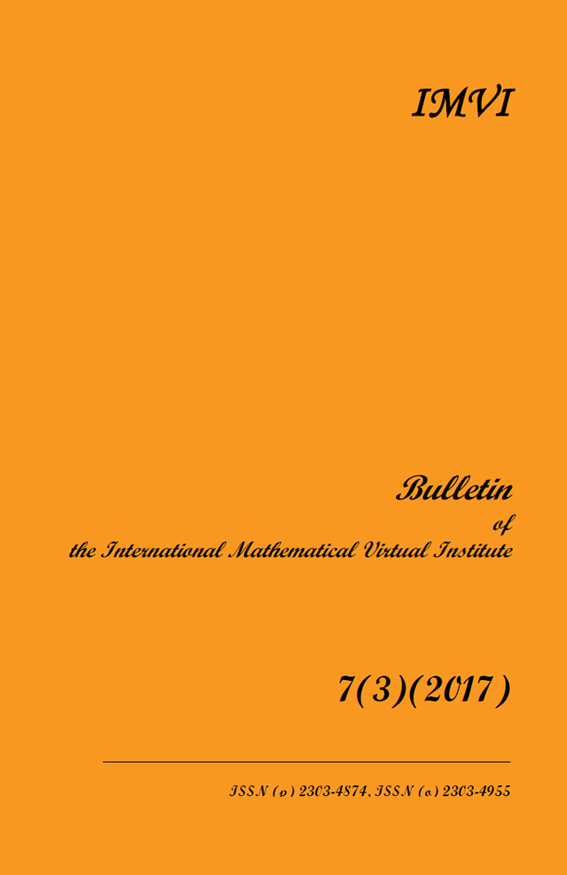Bi-Conditional Domination Related Parameters of a Graph – I
Abstract
In a graph G = (V;E), a set D V is a dominating set of G. TheBi-conditional domination number
(G : Pi) for 1 6 i 6 6, is the minimum
cardinality of a dominating set D such that induced subgraph ⟨D⟩ and ⟨V
References
[1] R. B. Allan and R.C. Laskar. On domination and independent domination number of a graph, Discrete Math., 23(1978), 73-76.
[2] B. Chaluvaraju, M. Chellali and K. A. Vidya, Perfect k-domination in graphs. Australasian J. Combina., 48 (2010), 175-184.
[3] B. Chaluvaraju and K. A. Vidya. Generalized perfect domination in graphs. J. Comb. Optim., Springer, 27(2) (2014), 292-301.
[4] T. C. E. Cheng, Y. Chen, C. T. Ng, A note on acyclic domination number in graphs of diameter two. Discrete Math., 154 (2006), 1019-1022.
[5] E. J. Cockayne, R. M. Dawes and S. T. Hedetniemi. Total domination in graphs. Networks, 10 (1980), 211-219.
[6] M. B. Cozzene and L. L. Kelleher. Dominating cliques in graphs. Discrete Math., 86 (1990), 303-308.
[7] G. Cyman, M. Lemanska, and J. Raczek, On the doubly connected domination number of a graph. Cent. Eur. J. Math., 4 (2006), 34-45.
[8] F. Harary. Graph theory, Addison-Wesley, Reading Mass. 1969.
[9] T. W. Haynes, S. T. Hedetniemi and P. J Slater. Fundamentals of Domination in Graphs. Marcel Dekkar, Inc. 1997.
[10] T. W. Haynes, S. T. Hedetniemi, and P. J. Slater. Domination in graphs: Advanced topics. Marcel Dekker, Inc, New York, 1998.
[11] T. W. Haynes and P.J. Slater. Paired domination in graphs. Networks, 32 (1998), 199-206.
[12] S. M. Hedetniemi, S. T. Hedetniemi and D. F. Rall. Acyclic domination. Discrete Math., 222 (2000), 151-165.
[13] B. Janakiram, N. D. Soner and M. A. Davis. Complementary acyclic domination in graphs. Journal of the Indian Math. Soc., 71 (1 - 4) (2004), 211-226.
[14] V. R. Kulli and B. Janakiram. The split domination number of a graph, Graph Theory Notes of New York, New York Academy of Sciences, 32 (1997), 16-19.
[15] V. R. Kulli, B. Janakiram and R. R Iyer. The cototal domination number of a graph. J. Discrete Math. Sci. Crypt., 2 (1999), 179-184.
[16] V. R. Kulli and B. Janakiram. The nonsplit domination number of a graph. Indian J. pure Appl. Math., 31 (2000), 545-550.
[17] V. R. Kulli and B. Janakiram, The strong split domination number of a graph. Acta Ciencia Indica, 32 (2006), 715-720.
[18] V. R. Kulli. Theory of domination in graphs. Vishwa Intl. Pub., 2010.
[2] B. Chaluvaraju, M. Chellali and K. A. Vidya, Perfect k-domination in graphs. Australasian J. Combina., 48 (2010), 175-184.
[3] B. Chaluvaraju and K. A. Vidya. Generalized perfect domination in graphs. J. Comb. Optim., Springer, 27(2) (2014), 292-301.
[4] T. C. E. Cheng, Y. Chen, C. T. Ng, A note on acyclic domination number in graphs of diameter two. Discrete Math., 154 (2006), 1019-1022.
[5] E. J. Cockayne, R. M. Dawes and S. T. Hedetniemi. Total domination in graphs. Networks, 10 (1980), 211-219.
[6] M. B. Cozzene and L. L. Kelleher. Dominating cliques in graphs. Discrete Math., 86 (1990), 303-308.
[7] G. Cyman, M. Lemanska, and J. Raczek, On the doubly connected domination number of a graph. Cent. Eur. J. Math., 4 (2006), 34-45.
[8] F. Harary. Graph theory, Addison-Wesley, Reading Mass. 1969.
[9] T. W. Haynes, S. T. Hedetniemi and P. J Slater. Fundamentals of Domination in Graphs. Marcel Dekkar, Inc. 1997.
[10] T. W. Haynes, S. T. Hedetniemi, and P. J. Slater. Domination in graphs: Advanced topics. Marcel Dekker, Inc, New York, 1998.
[11] T. W. Haynes and P.J. Slater. Paired domination in graphs. Networks, 32 (1998), 199-206.
[12] S. M. Hedetniemi, S. T. Hedetniemi and D. F. Rall. Acyclic domination. Discrete Math., 222 (2000), 151-165.
[13] B. Janakiram, N. D. Soner and M. A. Davis. Complementary acyclic domination in graphs. Journal of the Indian Math. Soc., 71 (1 - 4) (2004), 211-226.
[14] V. R. Kulli and B. Janakiram. The split domination number of a graph, Graph Theory Notes of New York, New York Academy of Sciences, 32 (1997), 16-19.
[15] V. R. Kulli, B. Janakiram and R. R Iyer. The cototal domination number of a graph. J. Discrete Math. Sci. Crypt., 2 (1999), 179-184.
[16] V. R. Kulli and B. Janakiram. The nonsplit domination number of a graph. Indian J. pure Appl. Math., 31 (2000), 545-550.
[17] V. R. Kulli and B. Janakiram, The strong split domination number of a graph. Acta Ciencia Indica, 32 (2006), 715-720.
[18] V. R. Kulli. Theory of domination in graphs. Vishwa Intl. Pub., 2010.
Downloads
Published
2017-04-12
Issue
Section
Чланци

